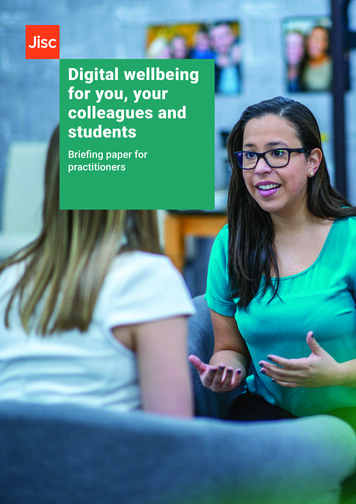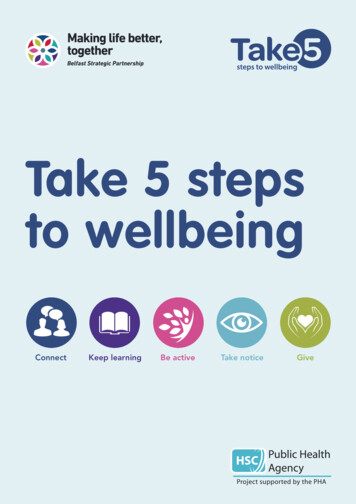
Transcription
Digital wellbeingfor you, yourcolleagues andstudentsBriefing paper forpractitioners
What is digitalwellbeing?Digital wellbeing:The impact of technologiesand digital services onpeople’s mental, physicaland emotional health.Digital wellbeing is one ofthe elements in our digitalcapabilities framework1.It is a term used to describethe impact of technologiesand digital services onpeople’s mental, physical,social and emotional health.It is a complex concept thatcan be viewed from avariety of perspectives andacross different contextsand situations.Jisc digital capabilities framework. Available online ability1Individual perspective – personal,learning and work contexts:this involves identifying and understandingthe positive benefits and any potentialnegative aspects of engaging with digitalactivities and being aware of ways tomanage and control these to improvewellbeing.Societal or organisationalperspective:providers of digital systems, services andcontent have a responsibility for ensuringthat these are well managed, supported,accessible and equitable. They also need toempower and build capability in users sothat all who engage with them are equippedto do so in a way that supports and/orimproves their wellbeing.Although it is important for individuals to take control oftheir digital wellbeing, they may not always have theopportunity or the ability to manage the impact oftechnologies or digital services on their lives. Forexample, in employment contexts where staff may notbe able to make changes or in personal contexts whereindividuals may not have access to, or be included in,digital opportunities that could have a positive effecton their lives. It is also important to remember thatindividuals may not have the support or capacity tocounteract negative effects of technologies.
Our model shows four aspects ofindividual digital wellbeingfor individuals.At the bottom of the model there are twotriangles that represent the potential positiveand negative impacts of technology onwellbeing. The middle triangle focuses on thepotential for technologies to improvewellbeing and top triangle emphasises thatindividuals need both awareness andcapacity to change their digital practices.
Different aspects of digital wellbeingTechnologies and digital activities can impact on physical, mental,social and emotional wellbeing in both positive and negative ways.How far these might affect an individual depends on their personalcontext, circumstances and capacity to deal with – or takeadvantage of these impacts. Digital wellbeing can be considered inthese four contexts: social, personal, learning and work.Digital socialwellbeingNegativesPositives Preventing isolationBuilding andmaintainingrelationshipsReducing lonelinessFull participation andconnection withfamily, friends andwider communitiesIncreasedopportunities forinclusion (egdisabled people)Digital personalwellbeing CyberbullyingOnline grooming(eg sex,radicalisation)Exclusion and/oraccessibility(eg gender, age,poverty)NegativesPositives Creating a positiveidentityBuilding self worthEnjoyment(eg games, funinteractions, music)Convenience/timesaving (eg shopping)Access to newideas/inspirationTools for physicalhealth Negative comparisonwith othersAddictive onlinebehaviours(eg gambling, porn,checking devices)Passive consumptionAccess to illegalactivities/materialsPersonal databreachesLack of access and/or being left behindLack of sleepImpact on physicalhealth (eg eye strain,posture, lack ofexercise)
Overlapping contextsWhile it can be helpful to focus on digital wellbeing within specific contexts, it is important to consider the ways inwhich these overlap. Colleges and universities are increasingly focusing on student personal and mental wellbeingwhich does include elements of digital wellbeing, such as the potential negative impacts of social media. People mayhave more control over their digital wellbeing in personal and social contexts than they do in a learning or a workcontext, but only if they have the knowledge, capacity and appropriate support to do so.Potential impacts of digital tools and practices/activitiesIn all contexts there are positive and negative potential impacts of interacting with digital tools, services, contentand activities:Digital learningwellbeingNegativesPositives Alternative waysto learnOnline collaborativelearning opportunitiesEngaging learningactivitiesPractice digital skillsfor employmentLearn digital skills fornew careers/careerchangeIncreased accessto learningMore engagingassessment andfeedbackDigital workwellbeing Lack of digital skillsDigital overloadNegative impact ofcompulsory onlinecollaborationTime learning newtechnologies not thesubjectInappropriate use oftechnologiesLack of choice (egtold whichtechnologiesto use)NegativesPositives ImprovedcommunicationGlobal collaborationFlexible workingTools to manageworkloadTools to makethings easierCreating positiveonline professionalidentityLinks to otherprofessionals/subject networks Digital overloadAlways on (24 houraccess)Changes to jobroles/activitiesAutomation of tasks(eg redundancy)Poor ergonomics
Managing your own digital wellbeing- positive actions for individualsAlthough education organisations have a duty of care to make sure their employees and students have a safe, legallycompliant and supportive digital environment to work and learn in, individuals have responsibility for aspects within theircontrol and should take appropriate steps to ensure they achieve and maintain a positive approach to digital wellbeing.Access and use appropriate training andguidance for digital systems and toolsrelevant to your learning and role. Ask fortraining and support if there are gaps in thesupport that your organisation providesTake time to explore and understand yourown digital preferences and needs,including permanent disabilities, temporaryimpairments and any mental or physicalhealth challenges that can affect technology use. Takeadvantage of adjustable features such as screen contrast,text size, colour adjustments, and use of assistivetechnologiesConsider the impact of digital activities onyour own and others’ health. Take steps toavoid bad practices. For example, reducenegative impact by: Observing good posture, taking regular screen breaks,adjusting monitor brightness, making sure you getenough sleep, avoiding addictive behaviours Challenge and avoid the negative online behaviour ofothers – know the appropriate channels to report this(likely to be referenced in your IT and acceptable usepolicy) Use security features like passwords and two-stepauthentication processes Report any environmental problems back throughappropriate channels (eg managers, IT services,learning resource staff and student welfare services) Take a proactive role in identifying potentialchallenges and sharing good practice ifyou canManage digital workload: this can be asignificant problem. Although technology canhelp to improve efficiency it can createunrealistic expectations that support will beavailable 24:7 and cause stress. Learn how to use digitaltools more effectively and familiarise yourself withtechniques and approaches that can help you to manageemails and avoid distractions.Note: while individuals can attempt to manage theirdigital workload, it is not solely within their control.Managers should consider the impact of digital workloadwithin staff appraisals, performance management andcontinuing professional development (CPD) activitiesMake sure you know how to use digitalequipment, tools, services and contentsafely. This will help to maintain yourphysical and mental health. This could include makingsure that your work and study environments areergonomically designed and comply with health andsafety requirements. Safe use also includes making surethat digital interactions don’t have a negative impact onmental health. Students and staff should be aware oforganisational guidelines about safe use and practicesCreate and manage a positive digitalidentity (professional and personal). It is up toindividuals how visible they would like to beonline and in digital communities, but all students andstaff need to be aware of their digital footprint and howtheir online activities, and those of others, can affect this.Always focus on making a positive contributionEnsure that any services, content andsystems that you provide or produce areaccessible and inclusive. Your college oruniversity will be working towards compliancewith EU and UK government regulations for the accessibilityof online content. There are also broader considerationsin relation to accessibility and inclusion that can impactsignificantly on individual digital wellbeing. Staff shouldbe aware of these and be working towards improvingaccessibility
Good practice principles to supportthe digital wellbeing of othersSome staff have a direct responsibility for aspects of student and staff digital wellbeing but it may not always be obviousto others when and how they too could provide support. Some students may also have a formal or informal role toplay here (eg digital ambassadorial roles, digipals or champions). These good practice principles highlight areas whenstaff could help learners to:Know how to effectively access and use thedigital content, systems and tools that yourorganisation providesBe able to choose the most appropriatetechnologies for learning or for specific tasksAccess and use appropriate technologicalsupport and guidanceUnderstand their own digital learningpreferences and needs (eg assistivetechnologies, personal learning environments)Manage digital workload and learning (egplanning and preparation, avoiding distraction)Safely use digital equipment, tools, services andcontent to maintain physical and mental health(eg observe good posture, follow guidelines andsafety regulations, take screen breaks, adjustmonitor brightness, get enough sleep and avoidaddictive behaviours)Use security features like passwords andtwo-step authentication processesDevelop digital capabilities to support theirdigital wellbeing (eg information, media,financial, data literacies)Create and manage positive digital identitiespersonally and in preparation for workTake opportunities to positively participate inappropriate communities (eg personal, political,social, educational, professional networks)There are many things that individuals can do to improve their digital wellbeing. The challenges lie in beingaware of how much the digital tools, services, content and systems are impacting on our wellbeing and, moreimportantly, in understanding how we can manage or control this.Students and staff need mechanisms to give feedback about things that affect digital wellbeing that areoutside their individual control.See also our briefing paper for senior leadersat digitalcapability.jisc.ac.uk and look out for aseries of case studies to be published in 2020
JiscOne CastleparkTower HillBristol, BS2 0JA0203 697 5800info@jisc.ac.uk
Digital social wellbeing. Positives Preventing isolation Building and maintaining relationships Reducing loneliness Full participation and connection with family, friends and wider communities Increased opportunities for inclusion (eg disabled people) Negatives Cyberbullying Online grooming (eg sex, radicalisation)











